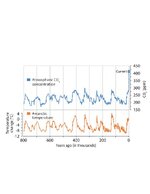I've noticed some confusion in this thread by the Climate-Denier-in-Chief so I've decided to present a very brief summary of "climate fluctuations." I hope that IIDB experts will scrutinize my remarks and make appropriate corrections.
Let's first dispose of the term "Climate Denier." We all know exactly what this term means. One of us needed to make a sophomoric joke about it -- he doesn't deny the Earth has a climate, and recently even stipulates that climate can fluctuate! We all got a big chuckle when he made this joke the first time: We were once all sophomores too! But it does wear thin. I suggest he make a YouTube or TikTok recording his joke. Then we can relive that sophomoric thrill as often -- or as seldom -- as we prefer.
Well you all seem so astonished that the climate fluctuates. I have to assume that many think that climate is static and does not change.
This claim of astonishment astonished me! Excepting Mr. Swizzle himself, is
anyone here arguing that climate is static and does not change?
More interesting is: What are the climate "fluctuations" Mr. Swizzle thinks he understands? The 24-hour day/night cycle effects a major temperature cycle, as does the seasonal variation over 366.24 sidereal days. Sunspot activity is roughly periodic at 11 years and has an effect on climate; and so does the El Niño Southern Oscillation. But surely Mr. Swizzle is much too good of a scientist to pretend that these oscillations are primary cause of the decades-long warming we have seen.
There is much confusion about the Milankovitch cycles. Some QOPAnoners do not seem to understand that the Earth's gross insolation, when averaged for a year across all latitudes is almost constant. What the Milankovitch cycles do effect is the portion of the insolation received at various latitudes. Heating land has more effect on the Earth's net temperature than heating water, because land ice forms more readily. Loss of glaciers reduces the Earth's albedo -- this positive feedback is a major driver of climate change. However the Milankovitch cycles have their weakest effect when the orbital eccentricity is low (i.e. the orbit is nearly circular) as is the case at present.
Note that such a glaciation/interglacial oscillation driven by the positive feedback of albedo requires a specific temperature range! The Earth must be cold enough for ice to form, but not so cold as to cover the earth in a snowball.
It is not known with certainty what caused the Earth to cool about 3 million years ago, leading to glaciation and a climate where hominids thrived. One possible cause is the closing of the Central American Seaway as plate tectonics pushed the South and North America landmasses together. Separating the cold water in the Eastern Pacific from the warm Caribbean increased ocean heat in the North Atlantic which (paradoxically?) increased ice production in Greenland.
Anyway, as we examine past fluctuation it is interesting to see how often the level of greenhouse gases, especially CO2, correlates strongly with temperature. With CO2 both cause and effect of warming, positive feedback means that small changes can have a big effect on global temperatures.
This is a key point that deniers of anthropogenic climate change overlook. They take exactly the WRONG conclusion from the FACT that there have been frequent temperature fluctuations in the past. The sharp fluctuations of the past
demonstrate that, due to positive feedbacks, the Earth's climate is FRAGILE. Two trillion tons of CO2 may seem like a tiny amount, but scientists understand that it has had a huge effect, and will continue to heat the Earth in coming decades.
Two specific changes may illustrate climate fragility. About 56 million years ago, methane hydrates in ocean sediments became warm enough to be released. This happened quite suddenly, and -- because methane is a greenhouse gas -- there was an EXTREMELY rapid rise in Earth's temperature, even bigger than the anthropogenic warming we currently enjoy. This sudden temperature rise caused massive extinctions.
Just a few million years later there was sharp temperature change in the opposite direction. With the extinctions, higher temperatures, and high concentration of CO2, multitudes of oceanic duckweeds (mosquito-ferns) thrived., sequestering carbon as dead duckweeds dropped to the ocean floor. This carbon sequestration caused temperatures to fall sharply.
Does any of this help, Mr. Swizzle? Do you see how the fragility of Earth's climate is a cause for concern about anthropogenic change, rather than a cause for celebration?


